
Happy New Year! I imagine we’re all very happy to greet 2021. I know that I’ve never been quite so happy to say goodbye to year, at least! And what better way to start the new year than with Bronze Age comics? Well folks, welcome back to a new edition of Into the Bronze Age! I’m excited to get into the December cover-dated books of 1971. Glancing at the cover gallery, it looks like we’ve got some fun stories in store of us! In fact, we’ve got a pretty darn good set of comics in this batch. There are some fun surprises and some real winners in this set. So, without further ado, let’s get started with what was going on in the world in December of 1971!
If you’re new to this little journey, you can check out the first post to learn what it’s all about.
- The Cambodian Civil War intensifies, with conflicts between government forces and Khmer Rouge rebels.
- Soviet space probe Mars 3 is first to soft land on Mars
- Abu Dhabi, Ajman, Dubai, Fujeira, Sharjah, and Umm ak Qiwain form United Arab Emirates and declare independence from the UK
- President Nixon commutes Jimmy Hoffa’s jail term
- The Indo-Pakistani War of 1971 begins after Pakistani strikes in Northern India, which connected to the Bangladesh Liberation War
- West German Chancellor Willy Brandt receives the Nobel Peace Prize
- Multiple bombings and clashes in Ireland that claim several lives, including several IRA members being caught in the blasts of their own bombs
- The Pakistani Army executes over 1,000 people in a genocidal ethnic and ideological purge of East Pakistan
- India and Bangladesh win their wars, and Bangladesh achieves independence
- Operation PUSH (People United to Save Humanity) formed by Jesse Jackson
- USA and Russia continue nuclear tests
- Important films released this month included the horrifying A Clockwork Orange, which says something about the zeitgeist of the age, though I hesitate to say precisely what
The Troubles in Ireland escalate a great deal this month, with bombing after bombing and violence abounding. What a terrifying time that must have been for those who lived through it, never knowing if a simple visit to a pub might end in injury or death. On a more positive note, Bangladesh won its independence from Pakistan this month, thanks in part to the support of India. In the US, things seem to have been fairly quiet as the nation approached Christmas. I wonder what that was like!
This month’s top song is the funky “Family Affair” by Sly and the Family Stone, which is apparently beloved but didn’t really grab me.
Roll Call
(You can see everything published this month HERE)
- Action Comics #407
- Adventure Comics #413
- Batman #237
- Detective Comics #418
- The Flash #211
- Green Lantern/Green Arrow #87
- Justice League of America #95
- Mr. Miracle #5
- Phantom Strange #16
- Superboy #180
- Superman #246 (#245 was all reprints)
- Superman’s Girlfriend, Lois Lane #117
- Superman’s Pal, Jimmy Olsen #144
- Teen Titans #36
- World’s Finest #208
Bolded entries are covered in this post, the others will be covered soon.
Action Comics #407
Executive Editor: Carmine Infantino
Cover Artists: Curt Swan and Murphy Anderson
Superman: “The Fiend in the Fortress of Solitude”
Writer: Cary Bates
Penciler: Curt Swan
Inker: Murphy Anderson
Editor: Murray Boltinoff
Atom: “The Challenge of the Expanding World (II)”
Writer: Bob Haney
Penciler and Inker: Alex Toth
Editor: Murray Boltinoff
Superman: “The Planet of Prey!”
Writer: Cary Bates
Penciler: Curt Swan
Inker: Murphy Anderson
Editor: Murray Boltinoff
We begin the month with a rather typical Superman yarn, replete with secret identity drama and over the top super-feats, though Bates manages to make it a readable enough tale out of these conventional ingredients. The cover is pretty much faithful to what we find inside, though the device of having Supes spying the characters outside the fortress and the attendant rock wall makes it a bit muddy. It’s a solid if unremarkable cover, which is fitting for the story within.

The adventure begins with a small plane in peril, as its pilot struggles to bring it in for an emergency landing in the frozen north. In fact, as it noses in for a crash landing, we discover that the misplaced plane has actually touched down at the foot of the Fortress of Solitude! Fortunately for the pilot, Superman happens to be at home and rushes the fellow to an Alaskan hospital (one imagines Iceland would be closer to the North Pole). However, it turns out that this seemingly innocent airman is actually a notorious criminal the Metropolis Marvel once put away. The hero remembers his face, but too late, as the scofflaw had already stolen a plane and escaped.
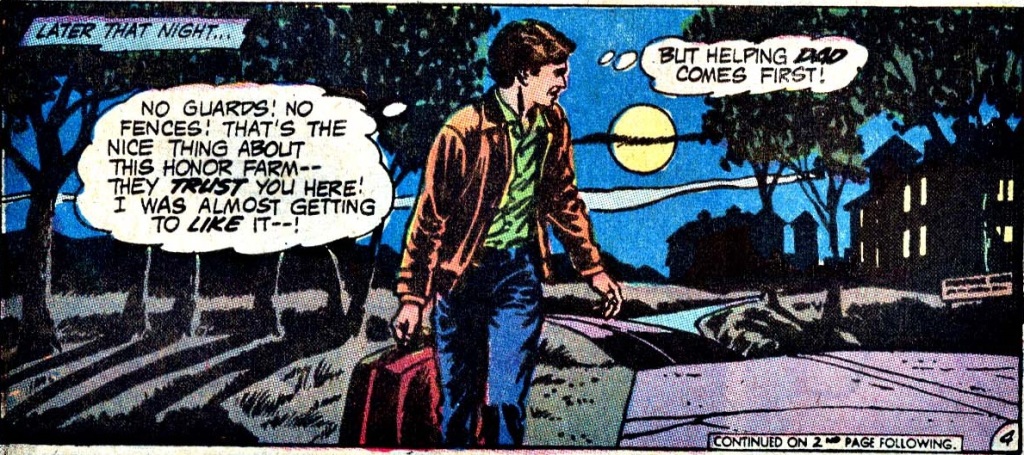
Unbeknownst to Superman, the flying fugitive, Michael “King” Andrews has gotten away with the knowledge of the location of the Fortress of Solitude, and he proceeds to plot to rob the place as his revenge, recruiting his son, Mike Jr., who is living at a reform school. In a relatively effective bit of characterization, we discover that the boy is actually starting to turn his life around, enjoying the trust he’s earned at the school, but he feels like he can’t let his father down. Of course, the kid’s possible redemption doesn’t seem to have sunk in all that well, as he happily kidnaps Clark Kent at gunpoint for his father. I guess his qualms aren’t all that serious after all. Kent, playing possum to protect his secret identity and thus establishing the pattern for this story, is brought to an abandoned airfield, where they meet the third member of this criminal conspiracy, a mysterious electronics expert that Mr. Mild-Mannered realizes is wearing a disguise!
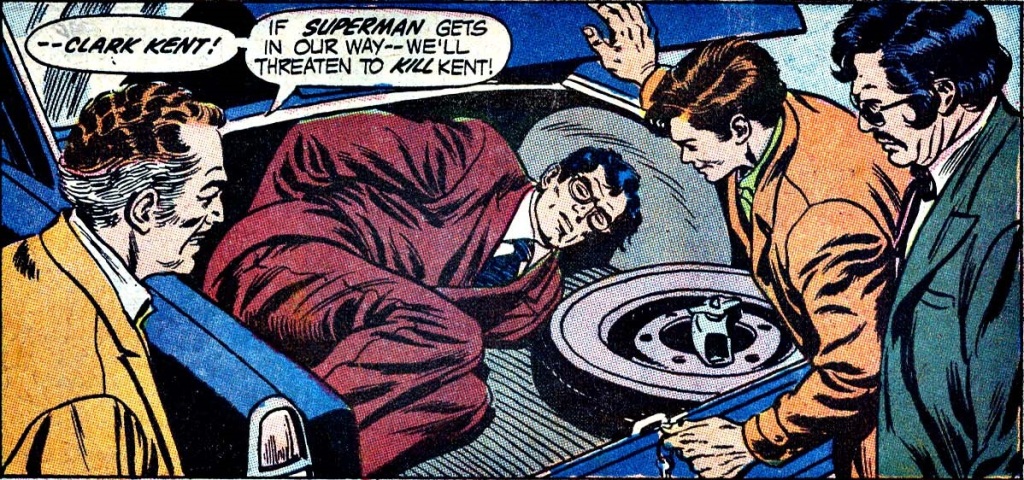
The quartet fly to the Fortress of Solitude, with “King” putting all the others to sleep, even his own son, remarking that a criminal can’t trust anyone. Once there, the electronics expert, Slesar, disables Superman’s security, and they break in (somehow without the gigantic key). Apparently the man-sized keyhole passes entirely through the door, which rather seems to defeat the purpose! Once inside, they lock Clark up and leave the boy to guard him, but a series of emergencies popping up around the globe force the undercover hero to create various distractions, allowing him to slip out and save the world, flying all the way around the globe, putting out fires and saving submarines (poaching in Aquaman’s domain there!), all in a matter of seconds, which is just plain ridiculous.
The power level of the Silver Age Superman certainly seems to be back to its full extent, and it is just plot-breaking. If the Man of Steel can zoom around the entire Earth and carry out various incredibly complex tasks, all in under ten seconds, than he certainly could have just zoomed away and captured the intruders without giving away his identity. This kind of thing rather bothers me. I’m fine with Superman using his super speed to zoom across a room and back faster than the eye can see, but when he does that on a planetary scale, it’s just too much!
Anyway, overblown power levels aside, the adventure comes to a head when “King” tells his son, worried about an apparently trapped Clark Kent, that he was just going to kill the reporter anyway, as ruthlessness is also required of a successful crook, a sentiment that “Slesar” shares, unfortunately for his partners in perfidy. The electronics expert reveals himself to be…Lex Luthor! It isn’t all that much of a surprise, but the revelation is still fun, and Luthor is truly nasty here, as he’s planted a bomb in the Fortress and plans on killing both the Andrews pair in cold blood to keep them from warning the Man of Tomorrow! “King” isn’t one to take such things meekly, however, and the two shoot it out, with Luthor”s lethal laser laying his foe low. That gives us another on-panel murder! The Comics Code Authority folks must have been asleep at the switch.
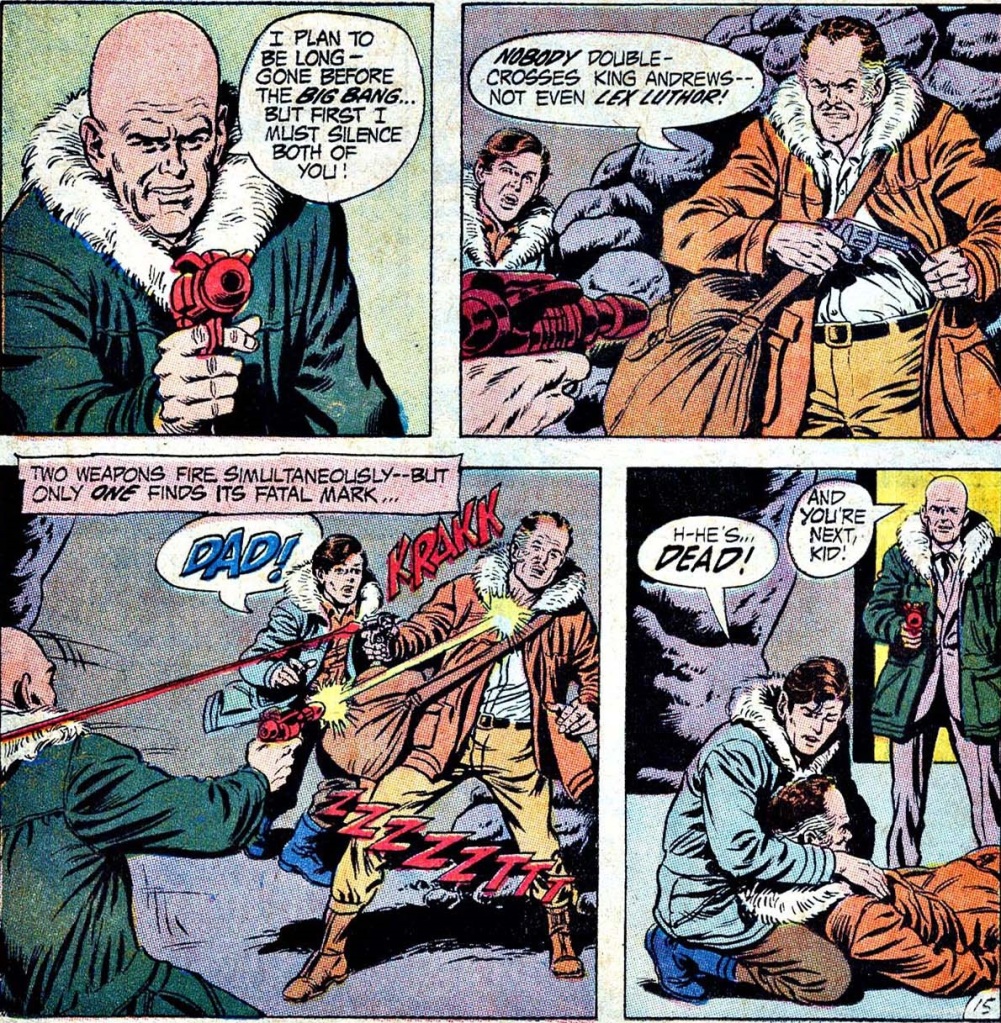
Just then, Superman returns and captures his nemesis (with a tap!), disposes of the bomb, and comforts the young Mike, who now sees the error of his ways and wants to avoid his father’s fate. Interestingly, the tale ends with the Action Ace asking Luthor if he truly hated him enough to sacrifice his own life to kill him, and Luthor’s sullen reply, “You know the answer to that, Superman” shows a surprisingly vicious portrayal of the character, which is striking.

Well, this was a solid, if unremarkable, story. The plot was pretty simple, with the secret identity antics, though fun to see thanks to Curt Swan’s lovely pencils, not terribly interesting to read. Yet, the different unique elements help it to stay entertaining. The understated arc of the young hoodlum, Mike Jr., and his discovery of his rotten father’s true character leading to his transformation is actually quite effective. Bates does a lot with those characters with very little “screen time”. Luthor’s plot and his cold ruthlessness are also an interesting addition, really marking him as an effective and threatening villain. It helps that he straight-up kills “King”, which is still a rarity in this era. Swan’s art is good throughout, and Superman’s side trips are quite striking. The ultimate result is a fine read that I enjoyed better than I expected. I’ll give it 3.5 Minutemen, as it is a little above average thanks to the subplots.
The Planet of Prey
This month’s backup is a lot more creative than our headline tale, resulting in a clever and interesting little sci-fi superhero adventure. It begins with the Action Ace returning home from a mission in space when he encounters a strange planetoid that veers into his path. When he approaches it, he finds himself besieged by the telepathic ‘squawking’ of a flock of alien avians. They swarm about the Man of Steel, but he easily and relatively gently dispatches them. Heading down to the surface, he discovers that the seemingly barren world has suddenly transformed into a miniature copy of Krypton, complete with micro-sized versions of his birth parents, Jor-El and Lara! They beckon him down, but Kal-El realizes they obviously can’t be his parents and heads back into orbit, feeling strangely drained from the effort.
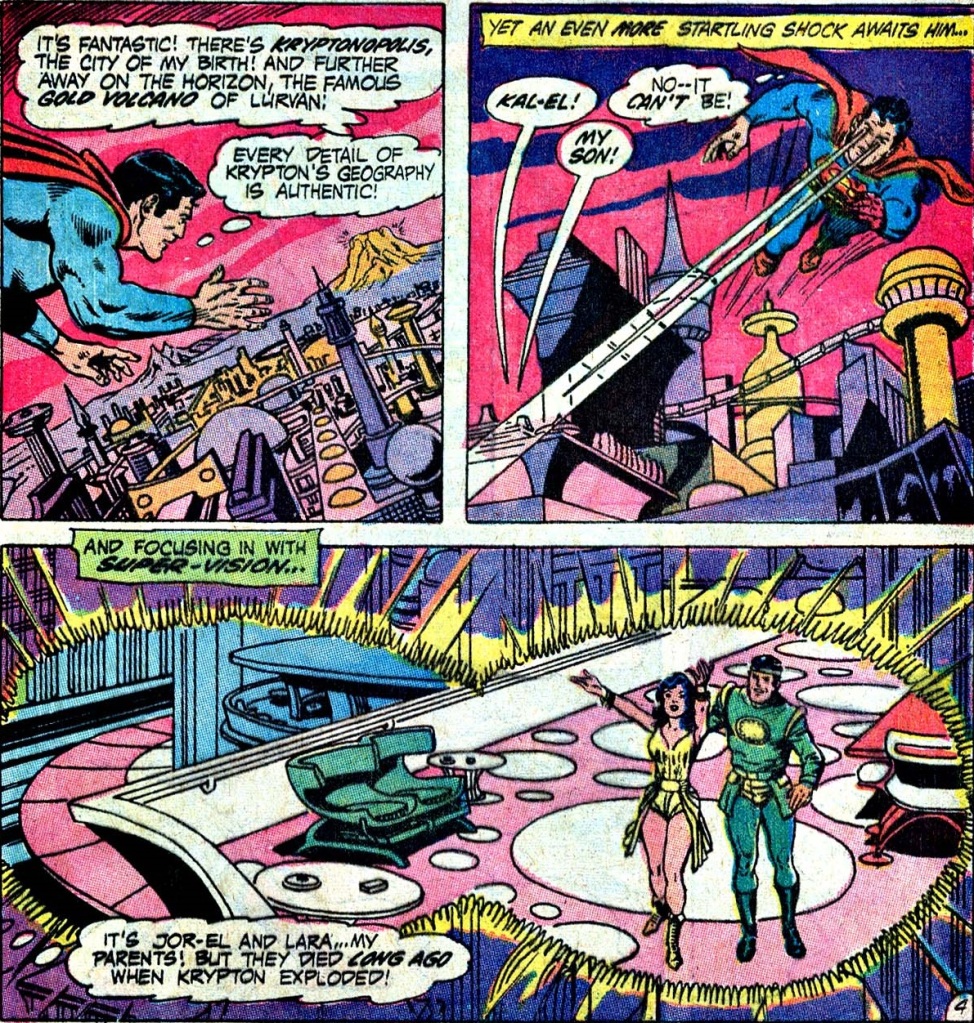
And this brings me to the small but crucial detail that really made me appreciate this yarn. Bates throws something strange and intriguing at his hero, but he still has Superman behave like a rational, intelligent person rather than a gullible idiot. In the typical version of this type of plot, characters who have seen illusions masquerading as loved ones hundreds of times seem to instantly and foolishly believe the evidence of their eyes and ignore the impossibility of the situation, doing intensely stupid things as a result. I really enjoyed that Bates didn’t go the way I expected when I saw fun-sized Jor-El. Instead, our Kryptonian traveler is confused and suspicious, which is the rational response to such a sight, and I appreciate that type of logical consistency.
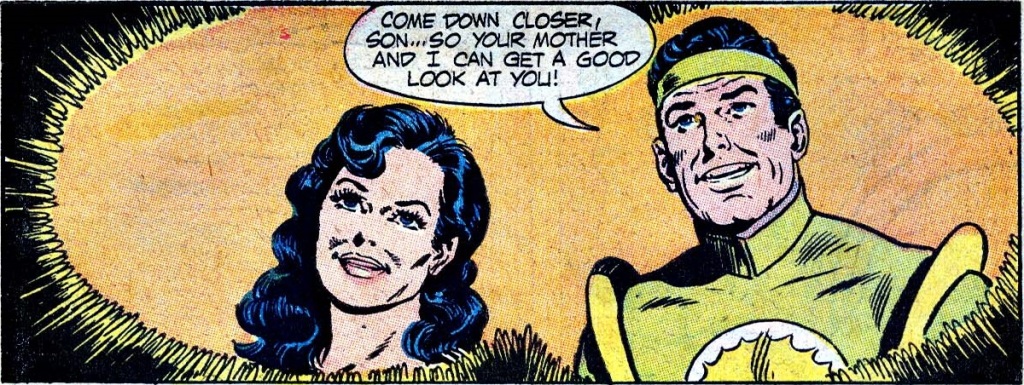
Anyway, once back in space, the Metropolis Marvel looks down to see that the world has now turned into a scale version of the Earth, complete with a tiny crumbling Metropolis and bite-sized Jimmy and Lois trapped within. Even then Superman doesn’t just rush in like a moron, but perplexed, he lands nearby, and then the trap springs! The illusion vanishes and the very soil seems to reach out to swallow him as the gravitic pull of the world suddenly increases a thousandfold!
In another clever moment, the Man of Steel tries to emulate the Fastest Man Alive, trying out his friend The Flash’s vibrating trick to escape. It isn’t enough, but just then he begins to hear telepathic messages of hope, and the alien birds from the beginning of the story arrive and break him free. They explain that he is now vibrating at their wavelength, enabling them to communicate with him. They tried to warn him off earlier, but he thought it was an attack. Apparently they live in a symbiotic relationship with this strange, predatory planetoid, which uses psychic illusions to lure in unwary spacefarers in order to consume them. Superman wonders why they would deprive themselves of sustenance, but surprisingly, they inform him that it was a purely mercenary action, as they have learned that the world becomes unhealthy for them when it consumes sentient life!

What a fun, creative, and unusual story! I thoroughly enjoyed reading it. I love that Bates told a story that maintained psychological realism and logical consistency, creating actual. reasonable motivations for his protagonist instead of having things just happen ‘because of plot.’ Even better, the central concept, although not completely unique, is interesting, and he really does keep you guessing as the adventure unfolds. I also love that last touch, that the alien creatures saved our hero, not because of altruistic motivations, but simply out of self-preservation! It’s a simple story, but it’s quite well crafted with a lot of small but significant creative touches. The art, of course, is lovely, and Swan gets to stretch his creative muscles with the alien creatures, doing a good job of rendering the different scales of his hero and the illusions. I’ll give this brief but high quality little outing 4.5 Minutemen!
Adventure Comics #413
Supergirl: “The Walking Bombs!”
Writer: John Albano
Penciler: Art Saaf
Inker: Bob Oksner
Letterer: Ben Oda
Editors: Joe Orlando and Mark Hanerfeld
Cover Artist: Bob Oksner
Hawkman: “Earth’s Impossible Day!”
Writer: Gardner Fox
Penciler/Inker: Joe Kubert
Letterer: Gaspar Saladino
Editor: Julius Schwartz
Zatanna: “Zatanna the Magician!”
Writer: Len Wein
Penciler/Inker: Gray Morrow
Editor: Joe Orlando
Robotman: “The Robot Ghost!”
Penciler/Inker: Frank Bolle
Editor: Whitney Ellsworth
Our Adventure Comics headline tale this month is an odd collection of elements that don’t quite fit together. It has some really charming touches, though, and Albano manages to give this Supergirl adventure some unique personality for the Maid of Might. All of this lies underneath a striking but strange cover. Our central image is pretty arresting, but it also doesn’t make a whole lot of sense. We’ve got a four-armed robotic walking bomb dressed up in a suit, apparently robbing a bank. If you were to take way the extra appendages, this would work reasonably well, capturing a moment of shocking discovery. However, if you think about the image for a minute, it make so no real sense. If you’re trying to pass off your android as a person, why in the world would you give him an extra set of arms? Other than that detail, which continues to bother me in the story itself, it is a nice-looking cover, which communicates the peril reasonably effectively.
The story begins with Linda Danvers rushing through town on some vital errand…specifically, she’s trying to get to a sale at a department store! In a fun detail, she thinks to herself that she can’t use her super speed to beat the rush because it wouldn’t be fair to the other shoppers. We join the disguised Girl of Steel as she tries on some different outfits, and the fashion themes of this book continue as Art Saaf indulges his inner fashion designer. Unfortunately, our young heroine indulges in a bit too much bargain hunting and has to head to the bank, only to discover that the place is being robbed! What’s more, the thief is a four-armed robot of all things! The Girl of Tomorrow ducks into a convenient alley and begins to change, only to discover that she’s got an audience in the form of a resident bum, who is quite happy to extend her hospitality. She is in too much of a hurry to find a handy telephone booth like her cousin, so she shoves the voyeur’s hat down over his eyes and completes her transformation into Supergirl. This whole exchange cracked me up. This is a hilarious and fun little scene that adds a sense of whimsy to the tale.
Once inside the bank, the Maid of Might is confronted with the towering android, who announces that if she interferes with his heist, he will blow the surrounding city blocks to smithereens! Just then, a young boy attacks the bank-robbing bot for stealing his mother’s deposit, and when the machine is about to strike the kid, it suddenly hesitates, and instead returns the money. How odd! Having no real choice, Supergirl lets the android escape in a flying sphere. She trails the fleeing felon to a secret underground lab, smashing in to find a turtleneck-wearing mad scientist who traps her in an electrical cage. The mastermind warns the Girl of Steel that if she breaks out, it will set off bombs in San Fransisco! As an aside, I hate it when writers mix real American cities with the usual DC geography. It blurs the lines of the setting, in my mind.
At any rate, our villain starts to monologue, and it is at this point that the major discordant note of the story enters the equation. The machine-making mad scientist tells his superheroic guest his tale of woe. His name is Robert Meekly, and he was a banker whose son suffered an accident that left him blind. The boy’s only hope was an operation that would cost $25,000, an astronomical amount for his hapless father. Meekly tries everything to raise the money, but his last hope, the president of his bank, refuses his loan, despite the fact that he’s served faithfully for 15 years. So, the desperate father does what he has to do and steals the money, going to prison as a result, but not before he gets his son the operation. To make things worse, while he was imprisoned, his wife took his son and disappeared.
Okay, now just hold on a minute…apparently our mad scientist learned robot building and bomb making…while working in a bank? Really? I know that super-science is easily accessible in the DC Universe, but come on! This is just ridiculous! Well, balmy bona-fides aside, the unfortunately named Meekly has come to deserve a less harmless name, as he now plans to get his revenge by robbing and blowing up banks across the country. He leaves our hobbled heroine to carry out his sinister scheme, and she prepares to escape, only to discover that her on-again-off-again powers are conveniently off again. Despite this limitation, the resourceful Supergirl manages to short out the electrical cage with a hair pin, which is another fun touch.

She interrupts Meekly’s machinations, only for him to try to strangle the powerless powerhouse! Even without powers, Linda is no pushover, and she breaks free. Then her powers return just as conveniently, and she smashes through the robotic roughnecks, but not before the mad Meekly manages to release some of his death machines, targeting two banks. The Maid of Might tells the irate inventor that his son is actually the teller at one of those banks! Meekly suddenly realizes his terrible mistake and agrees to help Supergirl stop the walking bombs. They split up, and he does indeed manage to capture his robotic bomber, but it blows up before he can dismantle it. While searching the wreckage, the authorities find the medal that Meekly was constantly playing with, and they realize that it was a little league award for his son.
Well, on that cheerful note, our tale ends, and we find ourselves with a discordant mixture of elements that just don’t really add up to a coherent whole. We’ve got a charming, off-beat opening, a tragic origin for our villain that doesn’t match his eventual M.O. at all, and then that downbeat ending. The banker-turned-supervillain mad scientist just doesn’t make any sense, but the basic plot is pretty straight-forward and works reasonably well. I find the little details of Supergirl’s shopping spree and changing challenges quite charming, and Albano seems to have a solid handle on her characterization. It seems that some of the themes that we’ve seen in this run of the series are continuing, with an ongoing emphasis on fashion and a uniquely feminine touch to some of the plots. That’s interesting, and I still find myself wondering just how much of the book’s contemporary audience was female and how well this focus worked. Despite those positive elements, I am already getting tired of the disappearing superpowers gimmick. I’d like to see more made of this or it wrapped up already. On the art front, Saaf’s pencils are quite pretty throughout, and he injects a ton of personality into his characters. I suppose this more or less all evens out, and I’ll give the whole kit and caboodle an average 3 Minutemen.
Zatanna the Magician
The highlight of the book and, quite possibly, the month, is this brief backup tale with Zatanna. It’s great fun, and boy is it gorgeous with Gray Morrow doing the art chores! It begins with our heroine’s retired father, Zatarra, researching “the realm of the supernatural” when he is ambushed by some spectral spooks who creep out of the woodwork in his study. Meanwhile, the Maid of Magic herself is in the basement talking to her manager, Jeff, trying to convince him that she should use legerdemain instead of her actual magical powers in her stage show. In a fun little sequence, Zatanna explains that, while real magic is very easy for her, almost like cheating, illusion takes skill and practice.
The pair head upstairs to get some coffee, only to be ambushed by her mind-controlled father, who banishes them into another dimension! The Mistress of Mysticism finds her powers outclassed and unable to transport them back, so they go in search of a natural “dimensional juncture” or meeting place between dimensions. She whips up a flying carpet, and away they go. Unfortunately, they suddenly find themselves under fire by a gang of barbarians. They land, and Zatanna whips up a sword and shield for Jeff, who objects that he doesn’t know how to use them. In a great sequence, the pair manage to hold their own for a few minutes but eventually get overwhelmed. Our tale ends with both dimensional exiles unconscious and in the hands of the barbarians, who remark that “the Master” will be pleased with them.
This is a great little story, just full of interest and color. It gives us an intriguing, all-too brief glimpse of the daily life of the magical pair and sets up an equally intriguing adventure, with Zatanna swept away into strange environs by her bewitched father. There’s some good action, some creative designs, and some nice character touches, with some good banter between The Maid of Magic and her manager, all packed into only 7 pages. Also, I’m tickled that the manager apparently gets his wardrobe from the same place as the ever-fashionable Geoff from Supergirl’s supporting cast, as he is dressed in the height of groovy 70s fashion. Of course, bringing all of this to life in inimitable style is Gray Morrow, who’s work is just plain lovely, while also being dynamic and full of energy. There’s never a panel where the characters are simply still and static; someone is always moving or interacting, with hair waving about or clothing in motion. It’s pretty impressive. The whole makes for a great story, and the only real problem with it is that there should be more of it, which is a great problem to have! I’ll give this delightful little adventure 4.5 Minutemen. I feel like Zatanna is a character with a lot of potential, but I’ve never really read a solo story with her, so I am quite looking forward to seeing more of her adventures!
Batman #237
Executive Editor: Julius Schwartz
Cover Artists: Neal Adams and Gaspar Saladino
“Night of the Reaper!”
Writers: Dennis O’Neil, Bernie Wrightson, Harlan Ellison
Penciler: Neal Adams
Inker: Dick Giordano
Letterer: John Costanza
Editor: Julius Schwartz
“The Screaming House”
Writer: Bill Finger
Pencilers: Bob Kane and Jerry Robinson
Inker: Bob Kane
Letterer: Jerry Robinson
Editor: Vincent Sullivan
Our Batman issue this month is, as usual, a cut above the average stories we’re seeing. It’s a pretty cool tale, with a fun setting and a surprising subject, though it has a bit of a tone problem, bouncing between spooky and funny, light hearted and heavy. We’ve got a pretty good cover, which is not much of a surprise from Neal Adams. It features a nice, menacing figure threatening Robin, creating good tension and interest, though the red background is a bit overpowering, I think.
The comic itself begins with a really striking splash page, featuring Batman pinned to a tree with a stake! How could this be? Well, it will be a little while before we get an answer, as we jump to a delightful two-page spread featuring Robin and three of his friends (who never get named, oddly enough), visiting the comic-famous Rutland Halloween Parade, which provided an opportunity for backdoor crossovers between DC and Marvel Comics in the Bronze Age. This real world phenomenon was a superhero themed event in Rutland, Vermont, which local writer and comic fan Tom Fagan, promoted in both DC and Marvel comics, featuring many attendees dressed as their favorite comic heroes, including comic book professionals. In the 70s, beginning with Avengers #83, both DC and Marvel creative teams began to use the event as a setting for unofficial crossovers between their characters. This Batman yarn is the second such and the first from DC.

Robin and his friends, who are apparently subtle cameos by comic creators (left to right, I think) Bernie Wrightson, Gerry Conway, and Alan Weiss, which is a really fun detail that I didn’t know until I started researching these “crossovers”. One of these friends, Alan, if my identification is correct, is a bit wacked-out because he’s been up for three days cramming for exams (and maybe taking stimulants more powerful than coffee!), and he’s obsessed with the floats. Also in attendance are costumed revelers dressed as such mixed Marvel and DC stars as Captain America, Hawkman, Havok, a bespectacled Aquaman, and a portly Man of Steel, among others. Unfortunately the festivities are interrupted by a fight, as three men jump a parade-goer dressed as….Robin! Dick and his buddies (minus the distracted Alan) charge over to even the odds, a concept that I always appreciate in fiction. Mr. Terrific would be proud!

Though the good Samaritans’ hearts are in the right place, they’re a bit outclassed, and soon Dick’s buddies get bashed, and he’s left to handle the situation by himself. He’s also got to do it without giving away his secret identity by fighting too well. He gets two of the toughs, but then Alan stumbles into him, giving the third an opening. Suddenly the Teen Wonder finds himself kissing pavement as the punks escape (I’m going to say that this doesn’t count as a Headblow for the Headcount, as Dick maintains consciousness). The roughed-up Robin replacement reveals that he doesn’t know what caused the attack, leading the real Robin to conclude that someone may have actually meant to target him, as the gunsels seemed like professionals. Slipping away, he dons his costume and starts to investigate, soon stumbling upon the transfixed Caped Crusader from our opening scene.
Tremblingly, the horrified hero approaches the tree, only to discover that the hanging form is not his pierced partner but a pegged party-goer in a Batman costume. As the Teen Titan tries to gather his wits, he’s attacked by the grim reaper, or at least a reasonable facsimile! Robin dodges a blow but trips on a rock and plunges over the cliff-side, striking his head on the rocks below (Man, Dick is really not coming off too well in this story, is he?). Fortunately, Batman arrives in the nick of time and pulls his imperiled partner from the drink before he drowns. The Dark Knight takes his sore sidekick to Tom Fagan’s house, where there is a Halloween party in full swing.
There Dick is treated by an aged German physicians, Dr. Gruener, who helps the Masked Manunter explain what he’s doing in Rutland. Apparently the doctor is a survivor of a concentration camp, a camp run by an escaped Nazi war criminal nicknamed “The Butcher.” They suspect that he’s hiding nearby, as the doctor having learned his former tormentor was in town. They hope that, since the Nazi was obsessed with masquerade parties, the superhero shindig of Rutland might lure him into the open. However, to complicate matters, Schloss, “The Butcher”, stole some gold from his fellow Nazis when he fled the sinking ship that was the Reich, and his former friends have found him as well and have dispatched a hit-squad to handle him.

Leaving Robin to recover, Batman heads out into the party to search for his quarry, and here we get some more fun cameos. Not only do we see a rather homemade Thor costume, but we also see Spider-Man, or rather, “Webslinger Lad.” In addition to the mighty Marvelites, Denny O’Neil himself is chatting with Thor, while Len Wein, looking like Cain from House of Mystery, provides snide commentary nearby. This is another great little meta touch. However, if you notice it, it does detract a bit from the search for a Nazi war criminal. On that subject, the Dark Knight heads outside, and finds the reaper’s latest victim with the help of the still dazed and confused Alan. While continuing his search, the Caped Crusader notices a light in the tower of Fagan’s house, a light being used as a signal. The Masked Manhunter ambushes a few of the Nazis hunting his target in a sequence that is a bit cooler in premise than in practice, as Adams’ art doesn’t quite capture the action like you’d expect, but he makes up for it in the following pages. Batman hauls one of the assassins out a window and dangles him off a roof to interrogate him. The fellow confesses that they planted a bomb in the traitor’s car, which explodes, killing “The Butcher”, despite Batman’s best efforts. It’s a really rather spectacular sequence.
The Dark Knight is angry and frustrated, and when Robin tries to comfort him, he lashes out, telling his partner that the case isn’t over, as the Nazis don’t account for all of the killings. But he knows who does. The Gotham Guardian sets out on a grim business, tracking down the Reaper, who he finally confronts, calling him by name….Dr. Gruener! The Holocaust survivor acknowledges the truth of Batman’s declaration, explaining that he simply couldn’t let “The Butcher” get away without getting his revenge, revenge for his entire family who died in the camps. He reported his discovery of the Nazi to the authorities, but then he thought better of it and tried to kill anyone who he thought might get in the way of his exacting his own revenge, like the Dynamic Duo. The Masked Manhunter struggles with his sympathy for the Doctor and his quest, but he ultimately rejects the sentiment, proclaiming that no man has a right to play judge and jury by himself (which is a nice character moment and a key component of who Batman is).
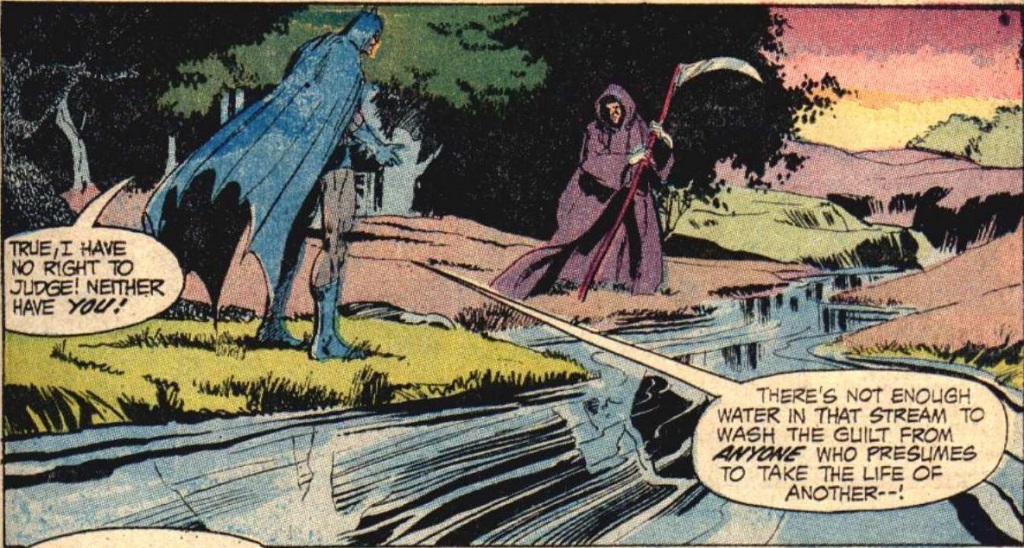
The pair struggle, but their fight comes to an unexpected and tragic conclusion when Alan wanders back into the scene, still dazed and confused. He bumps into Gruener as the older man is running across a dam, prompting the desperate doctor to prepare to kill him, only to see the Star of David the young man is wearing and finally realize that he was himself becoming a monster like the one who destroyed his family. Staggering blindly backwards, the doctor falls to this doom on the ground below as Batman looks helplessly on. It’s a really well-executed moment, and Adams’ art is superb.
This is a good story, though it is a bit uneven in tone, with moments of comedy, clever cameos, horror, and tragedy all fighting for space and balance. You can certainly have comedic beats in a story that tackles serious themes (the Marvel movies have turned that into an art form), but it feels incongruous here, especially because the transitions between those moments are a little too sharp and because O’Neil is dealing with just about the heaviest of heaviest themes, the Holocaust. Once again, he deserves some credit for tackling a pretty dark and serious topic for this era of comics, and he does some good work with it, making the camp survivor, Dr. Gruener sympathetic and tragic in fairly little space. Apparently it was Harlan Ellison’s idea to write a story on that subject, which is why he gets the credit at the beginning of the issue.
On the lighter side, all of the cameos and the Rutland setting itself are really fun. I can only imagine what a thrill it was as a young fan to see Thor sharing the page with Batman, even if only as a joke. It would be several years before there would be any official crossovers between DC and Marvel, so this would have been an exciting and almost unprecedented experience. Of course, Adams’ art is quite good, moody and dynamic, really delivering on the tension and action in many scenes, but there are also a few places where his figures or poses end up looking a tad odd, which is unusual for him. All-in-all, this is a good and entertaining read, even if it doesn’t quite come together. I’ll give it a solid 4 Minutemen.
That will do it for this set of stories, and a fine set it was! I hope that y’all enjoyed my coverage as much as I enjoyed writing it! Please join me again soon for the next batch of books as we continue our voyage Into the Bronze Age!

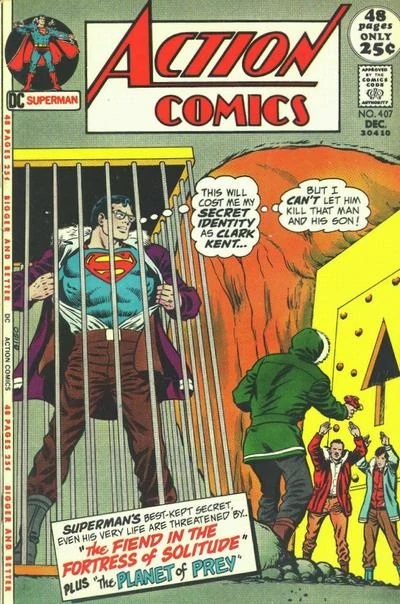





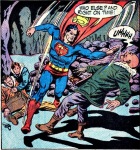


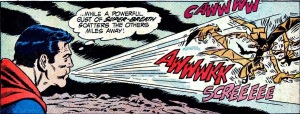



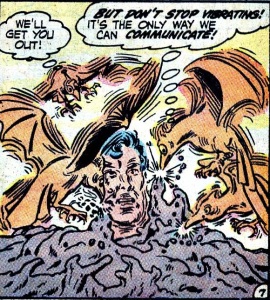

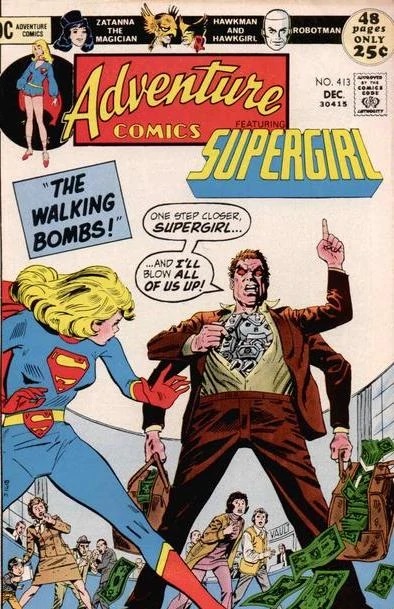
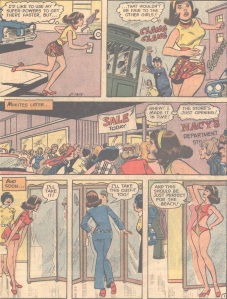
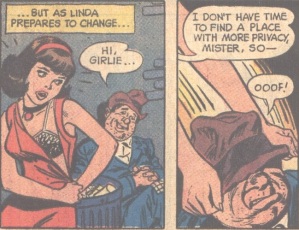




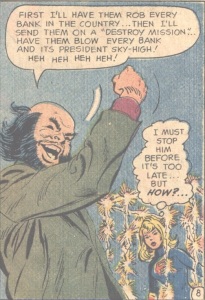




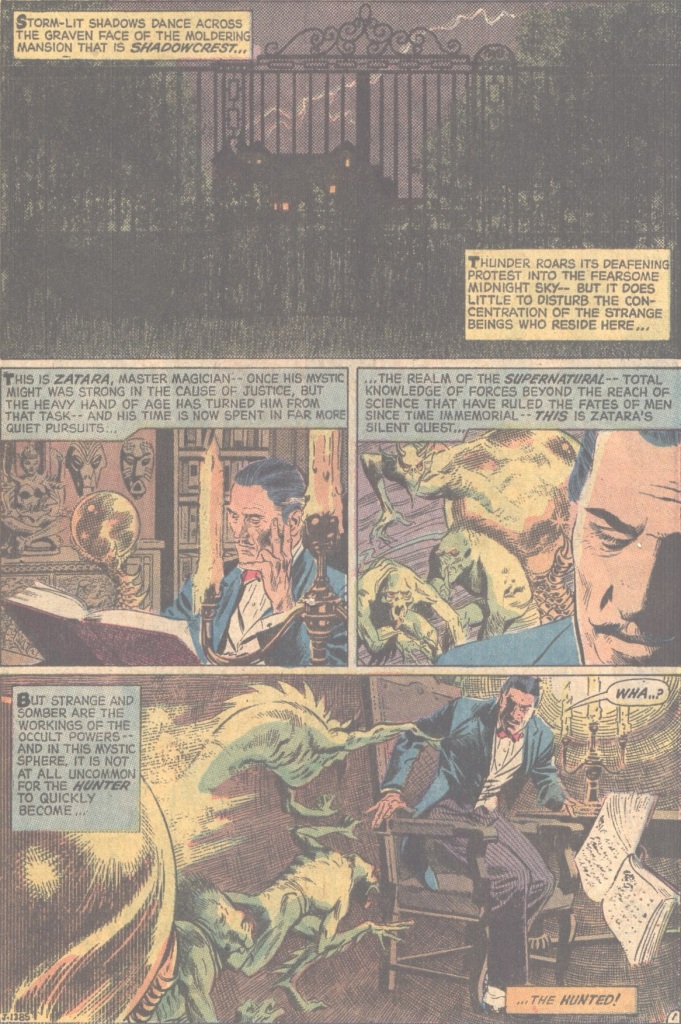
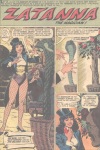



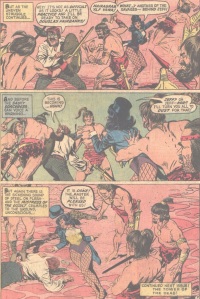
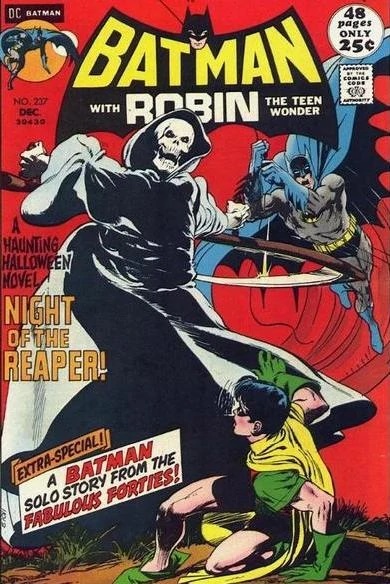
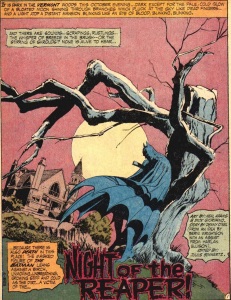
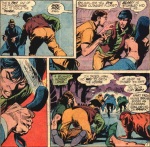






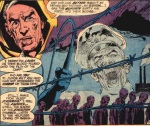


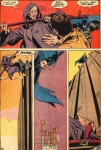

[…] a mostly positive review of Batman #237 on his blog The Greylands, Benton Grey opines that “Night of the Reaper!” is “a bit uneven in tone, with […]